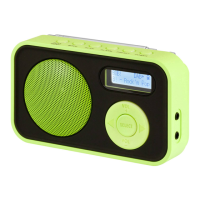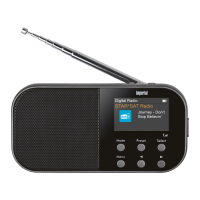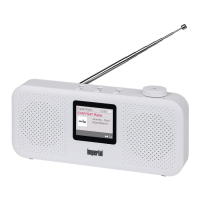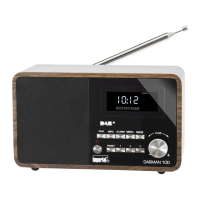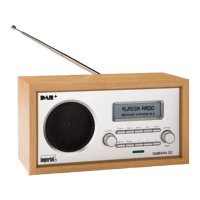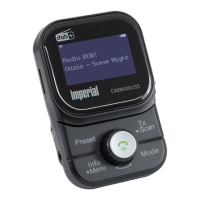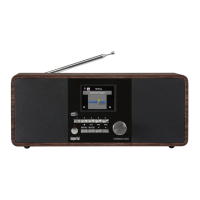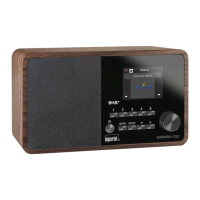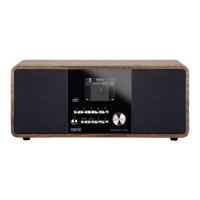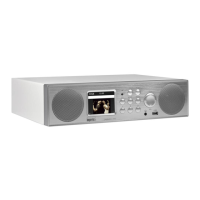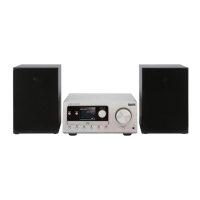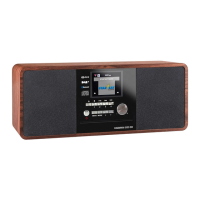Do you have a question about the Imperial DABMAN 13 and is the answer not in the manual?
Defines the intended use and limitations of the device for entertainment purposes only, indoors and for private use.
Explains the meaning of hazard symbols like DANGER, WARNING, ATTENTION, and NOTE used in the manual.
Describes the meaning of Protection Class II, CE mark, and indoor use symbol for electrical devices.
Provides safety instructions regarding device inspection, risk of injury for children, and choking hazards from packaging material.
Details risks of electrocution and fire, emphasizing checking for damage, using only supplied power units, and avoiding unauthorized alterations.
Warns against using the device in areas with high explosion risk, polluted air, or where solvents are stored.
Instructs on connecting the device safely to earthed power sockets, ensuring voltage compatibility, and proper placement.
Advises on protecting the device from moisture, heat, dust, and extreme conditions to prevent damage.
Warns about hearing damage and electromagnetic interference with medical devices.
Provides crucial safety warnings about battery handling, including risks of explosion, leakage, and ingestion.
Reinforces battery safety by advising against mixing types, proper storage, and avoiding disposal in fire.
Guides on device cleaning and outlines legal information regarding device use in EU countries.
Identifies the telescopic antenna used for receiving radio signals.
Explains the function of the INFO/MENU button for viewing information and accessing the device menu.
Describes the SCAN button's function to initiate a station search.
Details the PRESET button for opening saved stations or saving a new radio station.
Explains the SLEEP button's function to automatically switch off the radio after a set time.
Describes the MODE button to switch between reception modes like FM, DAB/DAB+, USB, or SD card.
Identifies the device's display screen.
Explains the Volume + button for increasing the audio volume.
Guides on navigating menus and selecting stations or options using navigation buttons.
Explains the OK button's role in confirming entries or selections.
Describes the POWER button for turning the device on or off.
Explains the Volume - button for decreasing the audio volume.
Details the USB port for connecting data carriers with music files for playback.
Describes the Micro SD card slot for playing music files from an inserted SD card.
Identifies the headphone jack for connecting headphones, which mutes the speakers.
Shows the Micro USB port for connecting the charging cable.
Instructs on how to insert the battery pack and charge the device using the USB cable, recommending an initial 2-hour charge.
Explains how to power on the device and notes that the channel finder automatically starts in DAB+ mode on first use.
Explains the information displayed on the device screen, including station name, mode, and battery level.
Describes how to select radio stations using the navigation buttons, noting how stations are ordered.
Explains how to arrange stored radio stations alphabetically or by detection order via the menu.
Details how to adjust the volume up or down using the dedicated volume buttons.
Guides on switching between FM and DAB+ reception modes using the MODE button.
Explains how to initiate FM and DAB programme searches using the SCAN button.
Describes how to save favourite radio stations into memory slots using the PRESET button.
Explains how to retrieve saved favourite stations using the PRESET button and navigation controls.
Details how to view additional information about the current radio station, such as genre and bitrate.
Explains how to set a sleep timer to automatically turn off the radio after a specified period.
Guides on setting up the alarm clock function, including alarm times, modes, types, and volume.
Instructs on setting the hours and minutes for the alarm clock function.
Explains how to set the alarm trigger mode (e.g., weekdays, daily).
Details how to choose the alarm sound type, including FM or DAB+ stations.
Guides on setting the volume for the alarm clock.
Describes how to play music files from a connected USB device and supported formats/sizes.
Explains how to pause, resume, and select tracks when playing music from a USB device.
Explains how to play music files from a Micro SD card and the supported formats/sizes.
Explains how to pause, resume, and select tracks when playing music from an SD card.
Instructs on how to dispose of packaging materials according to the 'Dual system' for recycling.
Explains the correct disposal method for the device, referencing Directive 2012/19/EU and recommending collection centres.
Advises on the separate disposal of batteries and power units, and where to find suitable collection bins.
| Radio type | Portable |
|---|---|
| Tuner type | Digital |
| FM band range | 87.5 - 108 MHz |
| DAB III band range | 174 - 240 MHz |
| Supported radio bands | DAB, DAB+, FM |
| Preset stations quantity | 20 |
| Display type | LCD |
| Built-in display | Yes |
| Thermometer | No |
| Antenna type | External |
| Product color | Silver, White |
| RMS rated power | 1.4 W |
| Audio formats supported | MP3, WAV |
| Number of built-in speakers | 1 |
| Headphone connectivity | 3.5 mm |
| USB 2.0 ports quantity | USB 2.0 ports have a data transmission speed of 480 Mbps, and are backwards compatible with USB 1.1 ports. You can connect all kinds of peripheral devices to them. |
| Apple docking compatibility | Not supported |
| Package type | Box |
| Certification | CE |
| Operating temperature (T-T) | 5 - 35 °C |
| Operating relative humidity (H-H) | 5 - 90 % |
| Power source | DC/Battery |
| Battery voltage | 3.7 V |
| Battery capacity | 800 mAh |
| Compatible memory cards | MicroSD (TransFlash) |
| Maximum memory card size | 32 GB |
| Cables included | USB |
| Depth | 32 mm |
|---|---|
| Width | 128 mm |
| Height | 72 mm |
| Weight | 209 g |
